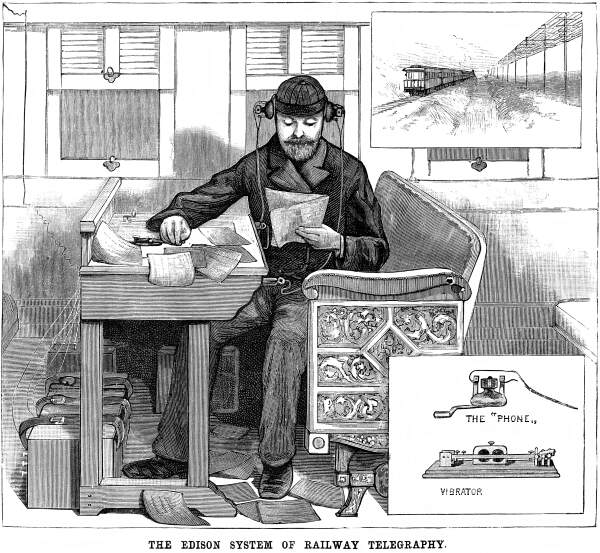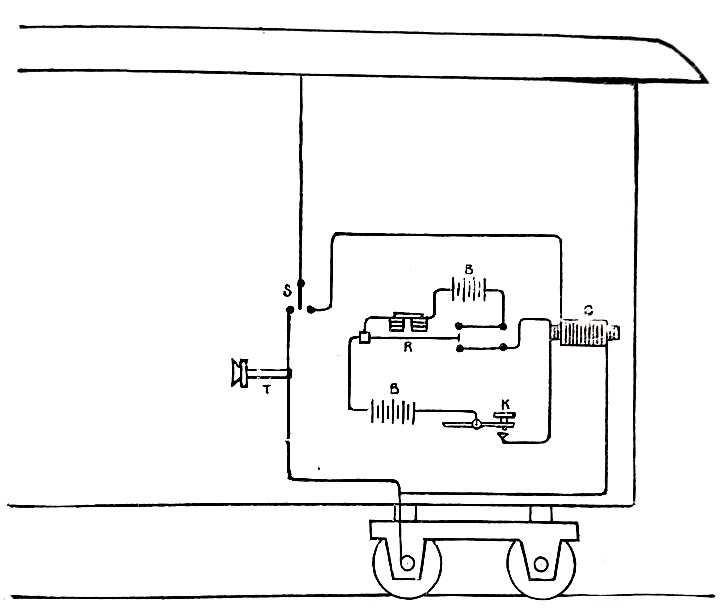How Edison Invented Wireless and Did Not Understand It
We are so accustomed to associate wireless communication with radio waves, that it seems impossible to us to invent a wireless telegraph before the famous experiments of Hertz 1887. Wireless electromagnetic communication supposedly automatically implies the radio and returns us to the eternal dispute about the priority of Marconi - Lodge - Popov.
However, as early as 1831, the law of electromagnetic induction was known to physicists. Although it is a necessary condition for the existence of radio waves, it can also be used independently, even if nothing is known about the waves. In particular, it can be used to create a wireless telegraph. One of the pioneers of this type of communication, long before Marconi, was Edison, proving himself to be a brilliant practitioner - and, alas, a completely hopeless theorist.
 Scientific american
Scientific american
In 1886, Scientific American publishes an amazing article , The Edison Rail Telegraph System , which describes not just a demonstration facility, but a full-fledged working wireless telegraph. Calling it completely wireless is still difficult, since he used ordinary telegraph wires running along the railway. But the transmission of messages from a moving train to these wires and back occurred solely due to the electromagnetic field.
')
Sheets of tin were used as the antenna, which covered the roofs of four carriages. In the reception mode, the wire from the antenna was directly connected by the key S through the speaker T to the ground, for which a copper plate pressed against the wheel axle of the car served as a spring. In the transfer mode, switch S closed another circuit consisting of battery B, telegraph key K, reed switch R and transformer C. . This voltage was then increased by a transformer and fed to the antenna.

Scientific american
It can be calculated that the length of an electromagnetic wave at a frequency of 500 Hz would be equal to 600 km. At the same time, the distance of wireless transmission in railway experiments was 5-6 m. The magazine also reported on other experiments of Edison, where the distance already reached 175 m. However, all these ranges are much smaller than the wavelength, and therefore, wave phenomena themselves and magnetic fields) and explain the work of the telegraph only by the law of induction. Apparently, this circumstance does not allow to rank Edison as the inventors of the radio.
Be that as it may, the magazine proudly concluded that Edison's telegraph, at a modest cost, opens up tremendous possibilities for preventing railway accidents and catching criminals. It is known that in 1888 this telegraph was used to keep in touch with trains stuck in snowdrifts during a snowstorm.
However, the most incomprehensible is the theoretical explanation Edison gave to his invention at the request of the correspondent. It is worth quoting verbatim:
It turns out that not even the “world ether”, but the most ordinary air forced Edison to use alternating current. It is curious to dream up how Edison imagined the work of his telegraph in a vacuum. Should the connection stop altogether? Or on the contrary, to work flawlessly even at a constant current, without encountering any resistance from the insidious dielectric in its path? But it seems that Edison was too persistent a pragmatist to be distracted by idle questions about the telegraph in a vacuum.
However, as early as 1831, the law of electromagnetic induction was known to physicists. Although it is a necessary condition for the existence of radio waves, it can also be used independently, even if nothing is known about the waves. In particular, it can be used to create a wireless telegraph. One of the pioneers of this type of communication, long before Marconi, was Edison, proving himself to be a brilliant practitioner - and, alas, a completely hopeless theorist.

In 1886, Scientific American publishes an amazing article , The Edison Rail Telegraph System , which describes not just a demonstration facility, but a full-fledged working wireless telegraph. Calling it completely wireless is still difficult, since he used ordinary telegraph wires running along the railway. But the transmission of messages from a moving train to these wires and back occurred solely due to the electromagnetic field.
')
Sheets of tin were used as the antenna, which covered the roofs of four carriages. In the reception mode, the wire from the antenna was directly connected by the key S through the speaker T to the ground, for which a copper plate pressed against the wheel axle of the car served as a spring. In the transfer mode, switch S closed another circuit consisting of battery B, telegraph key K, reed switch R and transformer C. . This voltage was then increased by a transformer and fed to the antenna.

Scientific american
It can be calculated that the length of an electromagnetic wave at a frequency of 500 Hz would be equal to 600 km. At the same time, the distance of wireless transmission in railway experiments was 5-6 m. The magazine also reported on other experiments of Edison, where the distance already reached 175 m. However, all these ranges are much smaller than the wavelength, and therefore, wave phenomena themselves and magnetic fields) and explain the work of the telegraph only by the law of induction. Apparently, this circumstance does not allow to rank Edison as the inventors of the radio.
Be that as it may, the magazine proudly concluded that Edison's telegraph, at a modest cost, opens up tremendous possibilities for preventing railway accidents and catching criminals. It is known that in 1888 this telegraph was used to keep in touch with trains stuck in snowdrifts during a snowstorm.
However, the most incomprehensible is the theoretical explanation Edison gave to his invention at the request of the correspondent. It is worth quoting verbatim:
Mr. Edison believes that he has made a new discovery in physics. He finds that bodies that have so far been considered non-conductive, such as air, in fact, become such only after some time. At the first instant of discharge, the air does not create any resistance to the passage of current, but almost immediately becomes polarized, and the connection is interrupted. So the idea behind these very short, high-voltage waves is to allow them to reach the wires before the air has time to create any resistance. However, the period between them is made sufficient to allow the air to return to its normal state and, therefore, allow the subsequent waves to pass.Edison cannot be denied some talent for “simple” explanations. In his argument about the non-instantaneous nature of the polarization of dielectrics, one can see a reasonable grain. However, the explanation as a whole does not hold water. Apparently, the passage of the signal through the air seemed to Edison precisely as a discharge in the literal sense of the word, a kind of lightning, but extremely short. The correspondent timidly adds that the word “discharge” probably needs to be understood conditionally, since we are talking about induction, and not about the overflow of charge. However, this idea does not find any development in the article and is not confirmed by the words of Edison himself.
It turns out that not even the “world ether”, but the most ordinary air forced Edison to use alternating current. It is curious to dream up how Edison imagined the work of his telegraph in a vacuum. Should the connection stop altogether? Or on the contrary, to work flawlessly even at a constant current, without encountering any resistance from the insidious dielectric in its path? But it seems that Edison was too persistent a pragmatist to be distracted by idle questions about the telegraph in a vacuum.
Source: https://habr.com/ru/post/454450/
All Articles